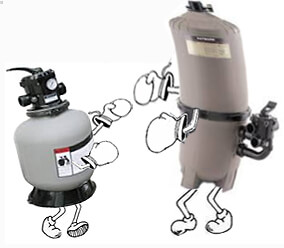
“What’s the Difference between Inground and Above Ground Pool Equipment?”
That is a question that may have crossed your mind at one time or another – usually when it comes time to buy an expensive piece of pool equipment, you may wonder if they are interchangeable.
The answer is… it depends, or maybe yes, maybe no. The main difference in pool equipment for inground and above ground pools is size – obviously, inground pool equipment is made to handle larger volumes of water, at higher flow rates.
Another obvious difference is price. I’m sure you noticed that above ground pool equipment is priced much lower than inground pool equipment. Margins are smaller for above ground equipment, due to a system of perfect pricing discrimination and product versioning, to create products that are more affordable for the above ground market, which presumably has less discretionary income than inground pool owners.
Let’s take a look at several product categories – pumps, filters, heaters and cleaners, and compare inground vs. above ground!
POOL PUMPS:
The main difference between inground and above ground pool pumps is that inground pumps are “self-priming”, and above ground pumps are not. This refers to the ability of the pump to lift water vertically, since most inground pumps are located above water level, and most above ground pumps are situated below water level. Above ground pumps have what’s called “flooded suction” and gravity and atmospheric pressure is feeding the pump without requiring a lot of suction or vacuum pressure. In ground pumps are usually 2-3 feet above the water level, and sometimes higher.
The second main difference between a/g and i/g pumps is flowrate. A/G pumps are designed to produce flow rates of 30-60 gpm, whereas I/G pumps can produce 75-150 gpm. Ideally, a pool pump should turnover all of the water (send it all through the filter) every 8-10 hours. A smaller pool will need a smaller pump to accomplish this, and any more is just overkill and wasted energy. In addition, pump flow rate must match filter flow rates – if the water is moving too fast through the filter, filtration suffers and the filter media can be damaged.
Can you use an above ground pool pump on an inground pool? Sure you can, as long as the pump is at or below the pool water level, and you have a very small pool. If the pump is able to turnover all of the water in 8-10 hours, and is able to reach (but not exceed) the pool filter Design Flow Rate, the intended use of the pump (a/g or i/g) really doesn’t matter.
POOL FILTERS:
Just like with pool pumps, the main difference in above ground and inground pool filters is size. Unless you want to clean your filter every other day, it’s important to have a filter that is properly sized to your pool (and your pump flow rate).
Inground and above ground pool filters are available in all 3 types – cartridge, DE or sand. They operate identically; the only difference is in size and design flow rate. Speaking of size, no matter what pool type you have – it’s always beneficial to have an oversized pool filter, but an undersized pool filter will barely keep up, with constant bouts of cloudy water and algae, and near constant cleaning or backwashing.
Can you use an above ground filter on an inground pool? Sure you can, as long as the filter is matched in size to a pump that can produce enough flow rate to turnover the water in 8-10 hours. However, the largest above ground pool filters are rated for under 15,000 gallons of pool water, so your inground pool would have to be rather small, to use an a/g filter.
POOL CLEANERS:
In the category of pool cleaners, there are more profound differences in models. Above ground cleaners are not just scaled down models of inground cleaners, but designed differently. Since above ground pools have 90° corners where the floor meets the wall, and less curvilinear shapes, above ground cleaners aren’t asked to climb walls, or navigate complicated curves, steps and deep ends. For this reason, they can be designed much more simply. They also have shorter hoses and cords, for coverage of a smaller pool.
For one thing, suction and pressure pool cleaners for above ground pools are made to operate with less water flow, produced from smaller (a/g) pool pumps. There are many suction-side pool cleaners for above ground pools, but only one (Polaris 65) pressure side pool cleaners. The difference between the two (in case you didn’t know), is that suction cleaners attach to a suction port like the skimmer, and pressure cleaners operate on a return line, with water under pressure being pushed to the cleaner.
Robotic cleaners are available for both i/g and a/g pools, with above ground models being much less powerful, again because they don’t need to climb walls, or climb back out of a deep end.
Can you use an above ground cleaner on an inground pool? I guess you can, if you don’t mind that it won’t climb the walls, and understand that it may get stuck in the deep end, without enough oomph to get back to the shallow end. Secondly, for suction and pressure cleaners, your pool should be rather small. Above ground pool cleaners are generally slower than inground models, so they will take longer to clean the pool. And, if you have a medium to large debris load in an inground pool, it may overwhelm some above ground pool cleaners.
POOL HEATERS:
For gas pool heaters and pool heat pumps, sizing a heater properly is done by considering pool size or surface area, average wind speed, average ambient temperature, and desired temperature rise.
Any heater, above ground or inground, installed on any pool will add some heat. A heater that is too small for a pool may only add 5-10 degrees to the pool water, less during colder ambient temps or windy days, and more during the hot part of the summer, or if you use a pool cover when the pool is unused. A larger heater however can add up to 30 degrees in temperature rise, no matter what the air temperature or wind speed. A cover is always recommended, to reduce recovery time and make any pool heater more efficient.
Solar pool heaters have less distinction between above ground and inground models – in fact, we sell the same solar heater for both pool types. For inground pools with a deep end and a larger surface area, more solar panels are needed to gain a reasonable amount of heat. But again, any amount will heat – it just depends on how much heat (temperature rise) you want.
Can you use an above ground pool heater on an inground pool? Sure you can, if it matches up to your pool size, and will produce enough heat to satisfy your demand. Using a pool cover (solar blanket or auto cover) will reduce the amount of BTU’s needed, so for a small pool under 15000 gallons, one could consider a smaller pool heater.
OTHER POOL EQUIPMENT:
Salt systems, chlorinators, purifiers can also be somewhat interchangeable, again – as long as it matches up to pool size (in gallons), and also matches your expectations. Smaller equipment will do less work, and do it more slowly than larger equipment.
Inground equipment can sometimes be used on above ground pools, but many times it is too large or too powerful, and could damage other equipment, or the pool itself.
One other consideration is pipe size. If you have 1.5″ or 2″ plumbing, you can’t connect to something with 1.25″ threaded ports – which is the pipe size for most above ground equipment.
In addition to pipe size, all equipment has a design flow rate – and if you push too much water, too fast through it, something is going to break, and it won’t perform as intended.
And speaking of the word intended – warranty claims may be denied if you are using above ground equipment on an inground pool – contrary to its intended use. Not that you’ll need a warranty, or it will even be considered.

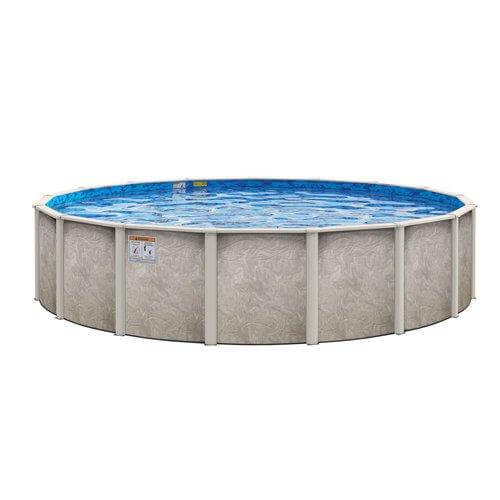
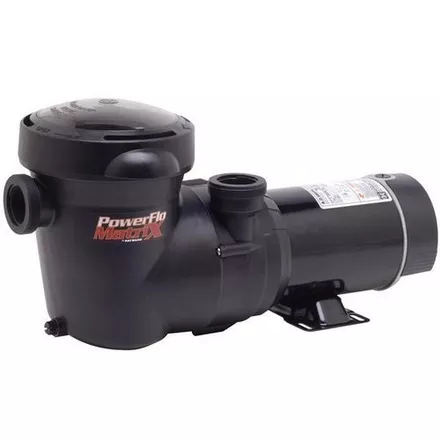
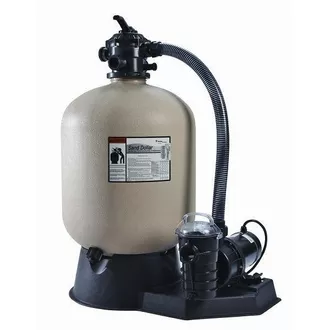
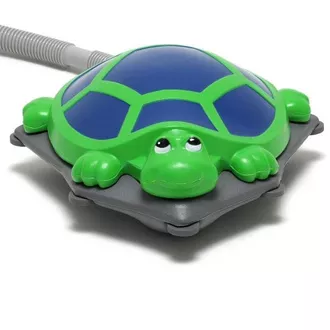
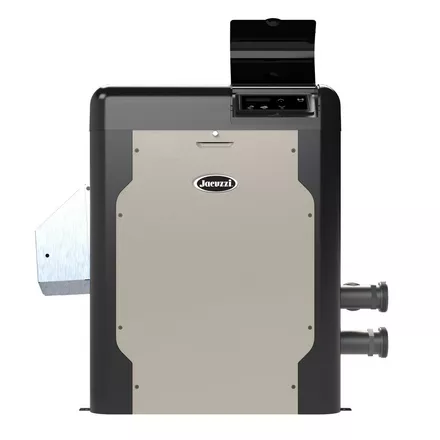
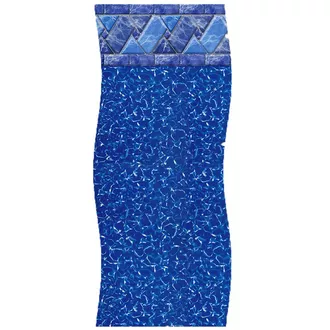
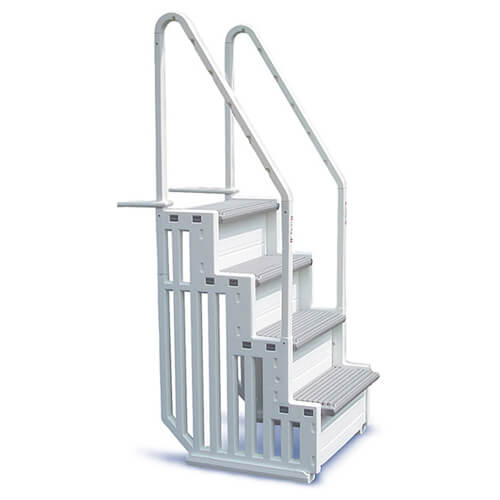
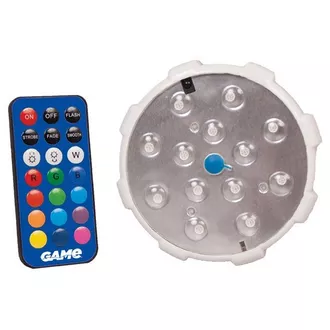
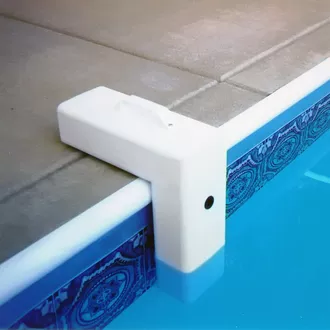
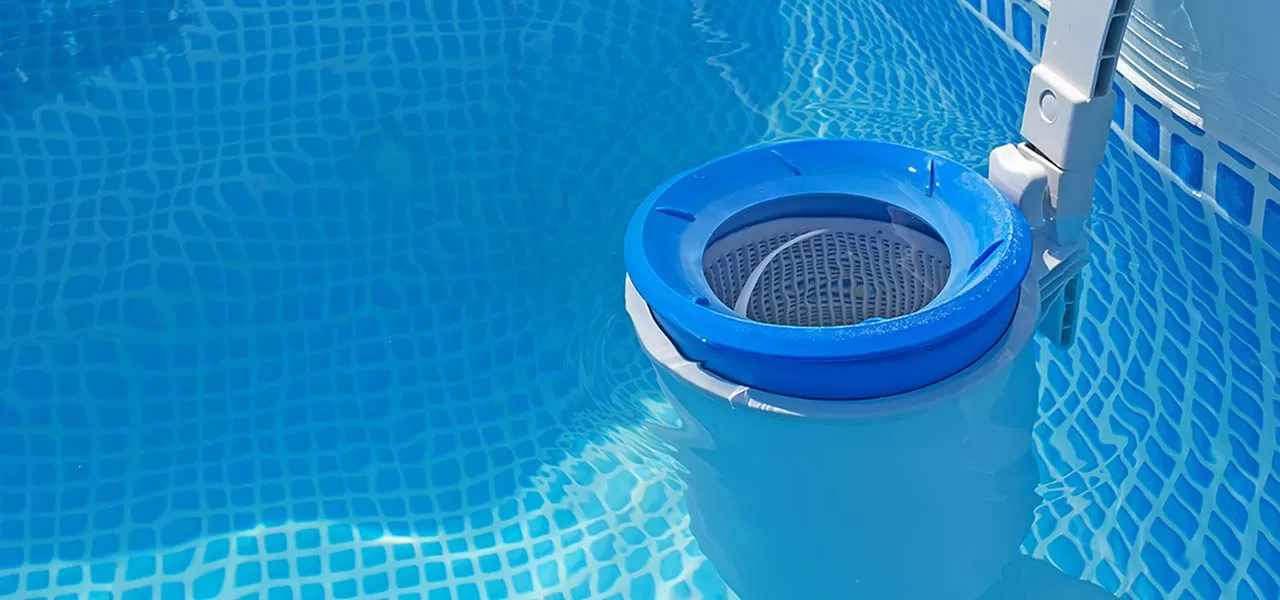
so a 1hp horsepower Hayward above ground pool pump will not be sufficient enough to power my inground pool that’s powered by a 1 horsepower Hayward pump?
Hi Josh, sure you can use a 1-hp abg pump on an inground pool, as long as the pump is not too far above water level, because most abg pumps are not self-priming, and as long as the flow rate produced by the pump meets the turnover requirement of pumping all water in the pool thru the filter in an 8-hour period, and also meets the filter “Design Flow Rate” specs.
What size DE would be the best choice and can I or should I go down to 1hp pump?
Hi Debbie, “If it was MY pool…” I’d go with the Crystal Water 48 SF DE filter, E4908, and pair that with a 1-hp Superpump, E2311, or you could pair the filter with a Variable Speed pump, like the Superpump VS or the Waterway 140
Good Morning,
My above ground pool is 24,000 gallons and has a deep end. We have had to replace the pump about once a year for the last 5 years. Our filter is 200# above ground. The pool gets full Texas sun and has to run 24/7 to keep it from turning green. I have a timer, but when I use it within 2 days I’m seeing green.
It is time to replace the pump …again! My pool store has been putting a 230v motor on a PowerFlo Matrix because we are hard wired for 230v.
I want to switch to an inground Hayward Max-Flo XL Pool Pump, 115/230V, 1.5 HP. My pool store is not recommending it. My pipes are 1.5.
I think I need the more powerful pump, but what do I know….
Can I get your opinion?
Hi Debbie, yes you can put an inground pump on an aboveground pool, however, the Hayward S210T sand filter is only rated for 44 GPM, and the Hayward Max-Flo XL Pool Pump can easily pump double that amount. That creates a filtering problem, and would only make matters worse, and could also likely cavitate with the existing suction lines not providing enough water to the pump. What I would recommend instead is to upsize the filter and the pump. Waterway has some very nice prices on some large DE and cartridge filters that would fix your algae problem. Then you could also use the Max-Flo if you want, or can use a smaller inground pump like the Hayward Superpump.
I have a a/g pump and filter I want to use as a pool vac. Is there a way to convert this to pull water so as to vacuum the pool?
Hi Bill, the problem with aboveground pumps is that they are not self-priming and may not lift above water level, which is why they are always placed below water level. But they may still work if placed on the pool deck. You just need some hose adapters. You could vacuum thru the filter and return to the pool, or just ‘vacuum to waste’ with the pump alone. See this post: https://blog.intheswim.com/how-to-make-a-pool-porta-vac-pump/ How to Make a Porta-Vac